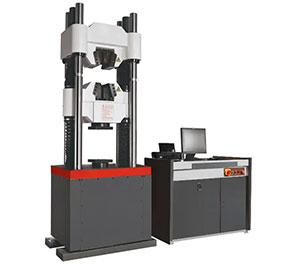

液龙机械
Voltage universal testing machine
Universal testing machine, a material testing machine integrating tensile, bending, compression, shearing, ring stiffness and other functions. It is mainly used for mechanical property testing of metal and non-metallic materials. Ideal testing equipment for departments such as quality supervision stations.
Universal testing machine is also called universal material testing machine, or tensile machine, double screw series, integrated structure of control, measurement and operation, integrated with contemporary advanced technology, with high precision, wide speed adjustment range, compact structure, convenient operation, The advantages of stable performance and so on. The electronic universal testing machine meets the requirements of GB/T1040, 1041, 8804, 9341, 9647, ISO7500-1, GB16491, GB/T17200, ISO5893, ASTMD638, 695, 790 and plastic pipes and other standards. It is suitable for tensile, compression, bending and creep tests of plastics, waterproof materials, textiles, paper products and rubber and other material samples and products. Equipped with a large pressure plate, it can directly perform flat compression (compression recovery), ring stiffness ( resistance to external load), creep ratio, ring tensile strength and other tests.
The universal material testing machine is the product of the combination of modern electronic technology and mechanical transmission technology. A number of performance tests have been carried out, and it has the characteristics of wide measurement range, high precision and fast response. Reliable work, high efficiency, can display, record and print test data in real time.
Common test items:
Tensile stress, tensile strength, breaking strength, elongation at break, constant elongation stress, constant stress elongation, constant stress force value, tear strength, arbitrary point force value, arbitrary point elongation, pull-out force , Adhesion and peak value calculation value, pressure test, shear peel force test, bending test, pull-out force puncture force test.
Special test items:
1. The property coefficient is defined as Young's modulus of elasticity: the ratio of the normal stress component in the same phase to the normal strain. To measure the coefficient of material rigidity, the higher the value, the stronger the material.
2. Proportional limit: The load can be maintained in a proportional relationship with the elongation within a certain range, and its stress is the ratio limit.
3. Elastic limit: the stress that the material can withstand without being deformed.
4. Elastic deformation: After removing the load, the deformation of the material disappears completely.
5. Deformation: After removing the load, the material still remains deformed.
6. Yield point: When the material is stretched, the deformation increases and the stress remains unchanged. This point is the yield point. The yield point is divided into upper and lower yield points, and generally the above yield point is used as the yield point. Yield: The load exceeds the proportional limit and the elongation is no longer proportional, the load will drop suddenly, and then within a period of time, the elongation will fluctuate up and down, and the elongation will change greatly. This phenomenon is called yielding.
7. Yield strength: The quotient obtained by dividing the load at which the elongation rate reaches a certain specified value when stretching is divided by the original cross-sectional area of the parallel part.
8. Spring K value: the ratio of the force component in the same phase as the deformation to the deformation.